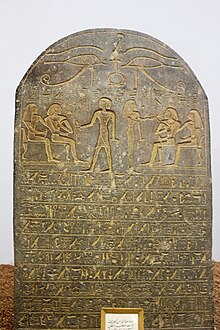Amenemhet (Prince of Teh-chet)
Amenemhet was a Nubian official in the service of the Egyptians in the 18th Dynasty.
In the New Kingdom , Lower Nubia was conquered by the Egyptians. Local elites were placed in the service of the pharaohs to administer the new province. Old tribal areas were placed under the rule of new, loyal princes. A tribal area was Teh-chet, the center of which must have been near today's Dibeira . The princes of Teh-chet ( wr-n-th-xt ) ruled here .
Amenemhet was prince of Teh-chet under the reigning queen Hatshepsut . His father Ruiu was also Prince of Teh-chet. After his death, his son Djehutyhotep succeeded him in office, who in turn was succeeded by his brother Amenemhet. Amenemhet is known from various monuments through which it is possible to trace his career. There is a statue from Buhen on which he appears as a simple scribe . On other objects he appears with the titles of Vigilant Leader of the Wife of God and the Courageous Leader in Lower Nubia . After the death of his brother he was made Prince of Teh-chet. His grave was found at Dibeira. It is an adobe pyramid with a chapel in which a stele was found that names him and his family.
Individual evidence
- ^ V. Davies: Statuette of Amenemhat. In: D. Welsby, J. Anderson (Eds.): Treasures from Sudan. British Museum Press, London 2004, ISBN 0-7141-1960-1 , pp. 104-105, no. 78.
- ^ Torgny Säve-Söderbergh: New Kingdom Pharaonic Sites, The Finds and the Sites (= The Scandinavian Joint Expedition to Sudaneses Nubia. Volume 5.2). Almqvist & Wiksell, Uppsala 1991, ISBN 917-081030-3 , pp. 194-196.
- ^ Torgny Säve-Söderbergh: New Kingdom Pharaonic Sites, The Finds and the Sites (= The Scandinavian Joint Expedition to Sudaneses Nubia. Volume 5.2). Almqvist & Wiksell, Uppsala 1991, ISBN 917-081030-3 , pp. 182-190.
| personal data | |
|---|---|
| SURNAME | Amenemhet |
| BRIEF DESCRIPTION | Prince of Teh-chet |
| DATE OF BIRTH | 16th century BC BC or 15th century BC Chr. |
| DATE OF DEATH | 15th century BC Chr. |
